Showing Spotlights 273 - 280 of 336 in category All (newest first):
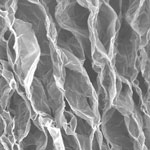 Integration of graphene sheets and its functional derivatives into three-dimensional macroscopic structures is drawing much attention since it is an essential step to explore the advanced properties of individual graphene sheets for practical applications, such as chemical filters and electrodes for energy storage devices. However, a major problem in scaling up production of graphene is the tendency of individual graphene sheets to aggregate due to strong van der Waals attraction. Restacking of sheets not only reduces their solution processability, but also compromises their properties such as accessible surface area. A novel approach uses a simple leavening strategy to prepare reduced graphene oxide (rGO) foams with porous and continuous cross-linked structures from freestanding compact graphene oxide layered films. The whole process is more like making graphene "bread". The rGO foams perform excellently as flexible electrode materials for supercapacitors and selective organic absorbents.
Integration of graphene sheets and its functional derivatives into three-dimensional macroscopic structures is drawing much attention since it is an essential step to explore the advanced properties of individual graphene sheets for practical applications, such as chemical filters and electrodes for energy storage devices. However, a major problem in scaling up production of graphene is the tendency of individual graphene sheets to aggregate due to strong van der Waals attraction. Restacking of sheets not only reduces their solution processability, but also compromises their properties such as accessible surface area. A novel approach uses a simple leavening strategy to prepare reduced graphene oxide (rGO) foams with porous and continuous cross-linked structures from freestanding compact graphene oxide layered films. The whole process is more like making graphene "bread". The rGO foams perform excellently as flexible electrode materials for supercapacitors and selective organic absorbents.
Aug 9th, 2012
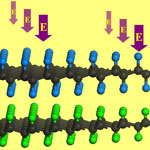 Researchers are putting great efforts into developing techniques to integrate graphene into nanoelectronic devices. Unfortunately, graphene has no band gap - a critical prerequisite for transistors - which essentially restricts its wider applications in nanoelectronics. Among the various techniques developed toward introducing a bandgap in graphene, hydrogenation or fluorination can efficiently solve this problem as they can open a considerable energy gap in the band structure of graphene. However, the experimentally realized fully hydrogenated and fluorinated graphene - namely graphane and fluorographene, respectively - both have a very large energy gap, which constrains their applications in electronics. Thus at present an urgent task is to find a feasible way which could reduce the energy gap of graphane or fluorographene into a desirable range. In new work, researchers have now demonstrated theoretically, using density functional theory computations, that graphane and fluorographene can be paired together through the C-H���F-C hydrogen bonds.
Researchers are putting great efforts into developing techniques to integrate graphene into nanoelectronic devices. Unfortunately, graphene has no band gap - a critical prerequisite for transistors - which essentially restricts its wider applications in nanoelectronics. Among the various techniques developed toward introducing a bandgap in graphene, hydrogenation or fluorination can efficiently solve this problem as they can open a considerable energy gap in the band structure of graphene. However, the experimentally realized fully hydrogenated and fluorinated graphene - namely graphane and fluorographene, respectively - both have a very large energy gap, which constrains their applications in electronics. Thus at present an urgent task is to find a feasible way which could reduce the energy gap of graphane or fluorographene into a desirable range. In new work, researchers have now demonstrated theoretically, using density functional theory computations, that graphane and fluorographene can be paired together through the C-H���F-C hydrogen bonds.
Jul 27th, 2012
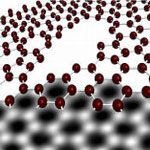 Although graphene in itself has been dubbed the 'magic' material, if it is to be used for practical applications it has to integrated with the other components of possible devices. For instance, to exploit its amazing electron conduction properties, you still need to connect it to the rest of the circuit with contacts, which are typically made out of metal. Understanding how metals interact - chemically and structurally - with graphene is therefore quite important and researchers have published a number of studies on the subject. In a quite unexpected discovery resulting from these observations, researchers have now found that graphene undergoes a self-repairing process to close holes that are caused by metal atoms. They were able to show that nanoscale holes (perhaps a 100 atoms missing or so), etched under an electron beam at room temperature in single-layer graphene sheets as a result of their interaction with metal impurities, heal spontaneously by filling up with either nonhexagon, graphene-like, or perfect hexagon 2D structures.
Although graphene in itself has been dubbed the 'magic' material, if it is to be used for practical applications it has to integrated with the other components of possible devices. For instance, to exploit its amazing electron conduction properties, you still need to connect it to the rest of the circuit with contacts, which are typically made out of metal. Understanding how metals interact - chemically and structurally - with graphene is therefore quite important and researchers have published a number of studies on the subject. In a quite unexpected discovery resulting from these observations, researchers have now found that graphene undergoes a self-repairing process to close holes that are caused by metal atoms. They were able to show that nanoscale holes (perhaps a 100 atoms missing or so), etched under an electron beam at room temperature in single-layer graphene sheets as a result of their interaction with metal impurities, heal spontaneously by filling up with either nonhexagon, graphene-like, or perfect hexagon 2D structures.
Jul 18th, 2012
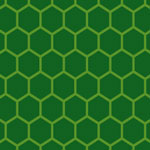 Graphene is undoubtedly emerging as the most promising nanomaterial because of its unique combination of superb properties, which opens a way for its exploitation in a wide spectrum of applications. However, it has to overcome a number of obstacles before we can realize its full potential for practical applications. One of the greatest challenges being faced today in commercializing graphene is how to produce high quality material, on a large scale at low cost, and in a reproducible manner. The major hurdle in manufacturing graphene on an industrial scale is the process complexity and the associated high cost of its production, which results in expensive product. In the present article, an attempt has been made to carry out an extensive survey and analysis of global patents pertaining to the various processes of graphene synthesis.
Graphene is undoubtedly emerging as the most promising nanomaterial because of its unique combination of superb properties, which opens a way for its exploitation in a wide spectrum of applications. However, it has to overcome a number of obstacles before we can realize its full potential for practical applications. One of the greatest challenges being faced today in commercializing graphene is how to produce high quality material, on a large scale at low cost, and in a reproducible manner. The major hurdle in manufacturing graphene on an industrial scale is the process complexity and the associated high cost of its production, which results in expensive product. In the present article, an attempt has been made to carry out an extensive survey and analysis of global patents pertaining to the various processes of graphene synthesis.
Jun 28th, 2012
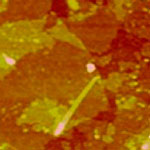 One type of biomolecules, enzymes, regulate almost all chemical reactions involved in numerous biological processes in living organisms and are also widely used in research and industry. Regulation of enzyme activity and stability is very important and has always attracted great attention. Various enzyme regulators, ranging from proteins, peptides, and synthetic organic molecules, have been discovered. Recently, nanomaterials evolve as promising alternatives for enzyme modulation. Nanomaterials provide large surface areas for biomolecule adsorption and can be engineered to present multiple surface functional groups for interacting with biomolecules, such as enzymes and/or their substrates. In a recent study, scientists started to explore the interactions between functionalized graphene oxide and serine proteases, a large family of enzymes with important biomedical and industrial applications.
One type of biomolecules, enzymes, regulate almost all chemical reactions involved in numerous biological processes in living organisms and are also widely used in research and industry. Regulation of enzyme activity and stability is very important and has always attracted great attention. Various enzyme regulators, ranging from proteins, peptides, and synthetic organic molecules, have been discovered. Recently, nanomaterials evolve as promising alternatives for enzyme modulation. Nanomaterials provide large surface areas for biomolecule adsorption and can be engineered to present multiple surface functional groups for interacting with biomolecules, such as enzymes and/or their substrates. In a recent study, scientists started to explore the interactions between functionalized graphene oxide and serine proteases, a large family of enzymes with important biomedical and industrial applications.
Jun 7th, 2012
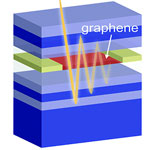 There is currently a very strong interest in using graphene for applications in optoelectronics. Graphene-based photodetectors have been realized before. By using graphene, researchers make use of the internal electric field that exists at the interface of graphene and metal. However, the low optical absorption of graphene - only 2.3 % due to its monoatomic thickness - leads to a low responsivity of these devices. Several groups worldwide are therefore currently pursuing different approaches to increase the interaction length of light with graphene and enhance the optical absorption. One novel approach is based on the integration of graphene into an optical microcavity. The increased electric field amplitude inside the cavity causes more energy to be absorbed, leading to a significant increase of the photoresponse.
There is currently a very strong interest in using graphene for applications in optoelectronics. Graphene-based photodetectors have been realized before. By using graphene, researchers make use of the internal electric field that exists at the interface of graphene and metal. However, the low optical absorption of graphene - only 2.3 % due to its monoatomic thickness - leads to a low responsivity of these devices. Several groups worldwide are therefore currently pursuing different approaches to increase the interaction length of light with graphene and enhance the optical absorption. One novel approach is based on the integration of graphene into an optical microcavity. The increased electric field amplitude inside the cavity causes more energy to be absorbed, leading to a significant increase of the photoresponse.
May 14th, 2012
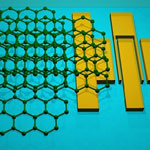 Gallium Nitride (GaN) is a semiconductor material commonly used in bright light-emitting diodes since the 1990s, which are now found in traffic lights and solid-state lighting. Thanks to its wide band gap, this very hard semiconductor material also finds applications in optoelectronic, high-power and high-frequency devices. However, a severe problem that afflicts high-power GaN electronic and optoelectronic devices is self-heating and the difficulties of heat removal. Researchers have now found an unusual solution for the thermal management problem of gallium-nitride technology: They demonstrated that thermal management of GaN transistors can be substantially improved via introduction of alternative heat-escaping channels implemented with graphene multilayers.
Gallium Nitride (GaN) is a semiconductor material commonly used in bright light-emitting diodes since the 1990s, which are now found in traffic lights and solid-state lighting. Thanks to its wide band gap, this very hard semiconductor material also finds applications in optoelectronic, high-power and high-frequency devices. However, a severe problem that afflicts high-power GaN electronic and optoelectronic devices is self-heating and the difficulties of heat removal. Researchers have now found an unusual solution for the thermal management problem of gallium-nitride technology: They demonstrated that thermal management of GaN transistors can be substantially improved via introduction of alternative heat-escaping channels implemented with graphene multilayers.
May 10th, 2012
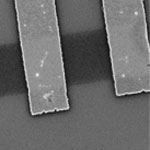 It has been known for some time that graphene can be used for detection of individual gas molecules adsorbed on its surface - a graphene sensor can detect just a single molecule of a toxic gas. However, the extremely high sensitivity of graphene does not necessarily translate into its selectivity to various molecules. In other words, it can be detected that some molecules attached to the graphene surface change the resistivity of a graphene field-effect transistor but one cannot say what kind of a molecules have attached. Scientists have therefore thought that truly selective gas sensing with graphene devices requires the functionalization of graphene surface with some agents specific for different gas molecules. In new research, though, scientists have now found that chemical vapors change the noise spectra of graphene transistors. The noise signal for each gas is reproducible, opening the way for practical reliable and simple gas sensors made from graphene.
It has been known for some time that graphene can be used for detection of individual gas molecules adsorbed on its surface - a graphene sensor can detect just a single molecule of a toxic gas. However, the extremely high sensitivity of graphene does not necessarily translate into its selectivity to various molecules. In other words, it can be detected that some molecules attached to the graphene surface change the resistivity of a graphene field-effect transistor but one cannot say what kind of a molecules have attached. Scientists have therefore thought that truly selective gas sensing with graphene devices requires the functionalization of graphene surface with some agents specific for different gas molecules. In new research, though, scientists have now found that chemical vapors change the noise spectra of graphene transistors. The noise signal for each gas is reproducible, opening the way for practical reliable and simple gas sensors made from graphene.
Apr 26th, 2012
 Integration of graphene sheets and its functional derivatives into three-dimensional macroscopic structures is drawing much attention since it is an essential step to explore the advanced properties of individual graphene sheets for practical applications, such as chemical filters and electrodes for energy storage devices. However, a major problem in scaling up production of graphene is the tendency of individual graphene sheets to aggregate due to strong van der Waals attraction. Restacking of sheets not only reduces their solution processability, but also compromises their properties such as accessible surface area. A novel approach uses a simple leavening strategy to prepare reduced graphene oxide (rGO) foams with porous and continuous cross-linked structures from freestanding compact graphene oxide layered films. The whole process is more like making graphene "bread". The rGO foams perform excellently as flexible electrode materials for supercapacitors and selective organic absorbents.
Integration of graphene sheets and its functional derivatives into three-dimensional macroscopic structures is drawing much attention since it is an essential step to explore the advanced properties of individual graphene sheets for practical applications, such as chemical filters and electrodes for energy storage devices. However, a major problem in scaling up production of graphene is the tendency of individual graphene sheets to aggregate due to strong van der Waals attraction. Restacking of sheets not only reduces their solution processability, but also compromises their properties such as accessible surface area. A novel approach uses a simple leavening strategy to prepare reduced graphene oxide (rGO) foams with porous and continuous cross-linked structures from freestanding compact graphene oxide layered films. The whole process is more like making graphene "bread". The rGO foams perform excellently as flexible electrode materials for supercapacitors and selective organic absorbents.
 Subscribe to our Nanotechnology Spotlight feed
Subscribe to our Nanotechnology Spotlight feed





